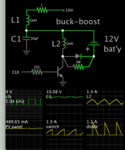JohnDave
Newbie level 4

Hi, I Am working on a Solar based DC-DC Converter its a BUCK-Boost converter, and As I read some of the articles related to the same topic Capacitor between PV Panel and DC-DC Converter is Mandatory.
So, anybody can guide to calculate the value for This Capacitor such as what is the proper formula or methods.
Thank you
So, anybody can guide to calculate the value for This Capacitor such as what is the proper formula or methods.
Thank you





